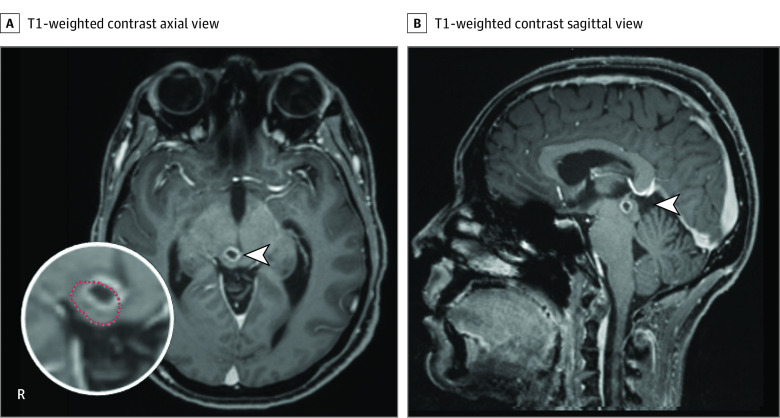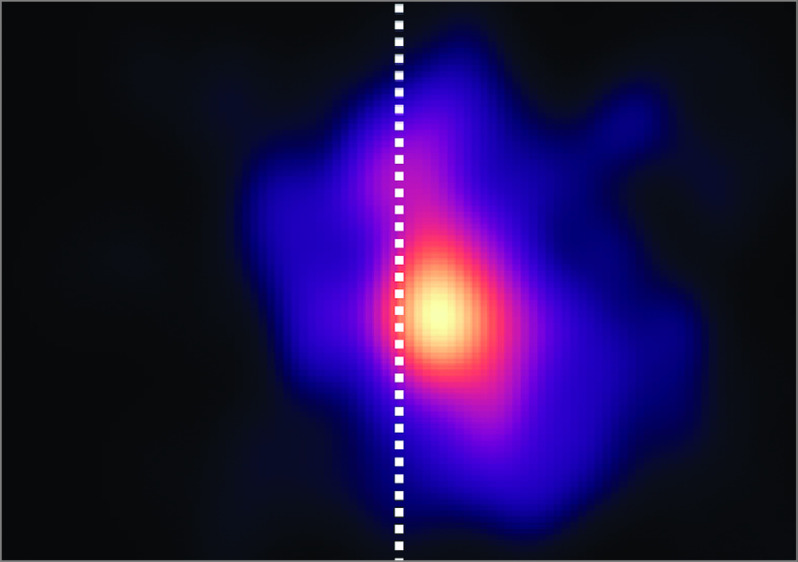Abstract
This case report describes an otherwise healthy young woman with a small abscess confined to the right superior colliculus.
Based on electrophysiological data from nonhuman primates and other species, models of visual attention predict that, in humans, the midbrain superior colliculus (SC) represents the last downstream structure of a large fronto-subcortical attentional network.1 This view is partly supported by human case studies showing that visuospatial inattention, often referred to as visual neglect, can occur after extensive brain lesions affecting, among others, the SC.1 Here, we show the rare case of a patient with a small lesion solely confined to the SC, confirming the models’ prediction and demonstrating that, in humans, an isolated SC lesion may result in contralesional visual neglect.
The SC receives retinal input predominantly from the contralateral visual hemifield, striate cortex, prefrontal cortex, frontal eye field, and parietal cortex.1 It processes visual input and controls the orientation of head and eye movements in response to visual stimuli. Experiments in animals have shown that the SC is also implicated in attentional mechanisms. For instance, inactivation of the SC in monkeys or cats results in neglect-like signs to targets presented in the contralateral visual field.1 However, a review of the PubMed database revealed that, to date, no direct evidence exists to show that an isolated lesion of the SC produces contralateral visual neglect in humans.
Methods
A woman in her 40s presented with a small abscess confined to the right SC (Figure 1).2 She was otherwise healthy. Because the data measured were part of a routine clinical examination and not a study, institutional board review approval did not apply. The patient gave explicit written consent for the use of her clinical data for research purposes and publication. The data of the 15 healthy control individuals were acquired as part of another study on free visual exploration, which was approved by the Ethics Committee Nordwest and Zentralschweiz, Switzerland.
Figure 1. T1-Weighted Contrast Magnetic Resonance Imaging (MRI), Showing an Abscess Confined to the Right Superior Colliculus.
In the magnified circle, the anatomical localization of the superior colliculus (arrowhead) is identified by the dotted red line, according to Wang et al.2 As the abscess lies within the anterior part of the superior colliculus, one can assume that, besides the superior colliculus itself, its afferent and efferent connections may also be damaged.
The unilateral involvement of the SC enabled us to observe an asymmetry in visual attention deployment, directly demonstrating the role of this structure in the latter. Our experimental protocol used a free visual exploration paradigm,3 quantifying visual attention deployment in the left and right hemispace by means of the horizontal distribution of visual fixations. We predicted that the mean number of fixations and the cumulative fixation duration would be decreased within the left contralesional and increased within the right ipsilesional hemispace. In addition, as previous data showed an ipsilesional bias in early attentional orientation in neglect,3 we also tested the hypothesis that the first saccade would be less frequently directed toward the contralesional left hemispace. 2-sided P values were statistically significant at P < .05. Analyses were done using Singlims.4
Results
Three months after diagnosis and medical treatment, the analysis of the free visual exploration behavior revealed a mean gaze position of 2.143° visual angle, above the cutoff of 1.333°, indicating neglect.3 Statistical analyses4 (Figure 2), comparing the patient’s oculomotor data against those derived from 15 age- and sex-matched healthy controls (HC), confirmed our hypothesis of a leftward neglect, with significantly fewer fixations (patient: 5.208; HC: mean [SD], 10.858 [1.422]; t = −3.848; P = .002) and lower cumulative fixation duration (patient: 1512 milliseconds; HC: mean [SD], 2815 [196] milliseconds; t = −6.450; P < .001) within the left contralesional hemispace, and significantly more fixations (patient: 14.125; HC: mean [SD], 11.223 [1.265]; t = 2.222; P = .04) and higher cumulative fixation duration (patient: 4114 milliseconds; HC: mean [SD], 2982 [307] milliseconds; t = 3.573; P = .003) within the right ipsilesional hemispace. Also, the patient’s first saccade was significantly less often directed toward the contralesional left hemispace (patient: 8.333%; HC: mean [SD], 61.677% [22.426%]; t = −2.304; P = .04). No difference was found in mean fixation duration (patient: left, 290 milliseconds and right, 291 milliseconds; HC: mean [SD], left, 263 [35] milliseconds; t = 0.765; P = .46 and right, 268 [35] milliseconds; t = 0.641; P = .53). A follow-up measurement, performed 9 months after diagnosis, showed an improvement of neglect in terms of mean gaze position (0.978°), but the persistence of pathological findings in other parameters (cumulative fixation duration: left, 2151 milliseconds; t = −3.288; P = .005; right, 3743 milliseconds; t = 2.401; P = .03; early orientation left, 8.333%; t = −2.304; P = .04).
Figure 2. Heatmap Plot of the Fixation Distribution in the Patient.
The dotted white line represents the middle of the screen. Three months poststroke, the heatmap plot of the fixation distribution in the patient shows a shift in the exploration behavior towards the right ipsilesional hemispace.
Discussion
The investigation of this rare case provides direct evidence for the role of the SC in directing visual attention and the eyes toward the contralateral hemispace, supporting the view that, in humans, the SC is not merely a node in the descending visual attention pathway, but is in fact a crucial neural substrate of visual attention control itself. Furthermore, the fact that this patient still had evidence of neglect after months is consistent with the view that monkeys have a more developed subcortical visual pathway than humans.5
References
- 1.Krauzlis RJ, Lovejoy LP, Zénon A. Superior colliculus and visual spatial attention. Annu Rev Neurosci. 2013;36(36):165-182. doi: 10.1146/annurev-neuro-062012-170249 [DOI] [PMC free article] [PubMed] [Google Scholar]
- 2.Wang YC, Bianciardi M, Chanes L, Satpute AB. Ultra high field fMRI of human superior colliculi activity during affective visual processing. Sci Rep. 2020;10(1):1331. doi: 10.1038/s41598-020-57653-z [DOI] [PMC free article] [PubMed] [Google Scholar]
- 3.Kaufmann BC, Cazzoli D, Pflugshaupt T, et al. Eyetracking during free visual exploration detects neglect more reliably than paper-pencil tests. Cortex. 2020;129:223-235. doi: 10.1016/j.cortex.2020.04.021 [DOI] [PubMed] [Google Scholar]
- 4.Crawford JR, Garthwaite PH. Investigation of the single case in neuropsychology: confidence limits on the abnormality of test scores and test score differences. Neuropsychologia. 2002;40(8):1196-1208. doi: 10.1016/S0028-3932(01)00224-X [DOI] [PubMed] [Google Scholar]
- 5.Mohler CW, Wurtz RH. Role of striate cortex and superior colliculus in visual guidance of saccadic eye movements in monkeys. J Neurophysiol. 1977;40(1):74-94. doi: 10.1152/jn.1977.40.1.74 [DOI] [PubMed] [Google Scholar]




